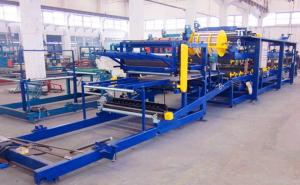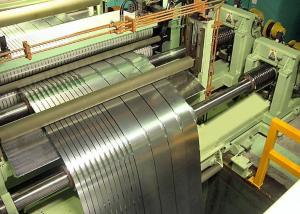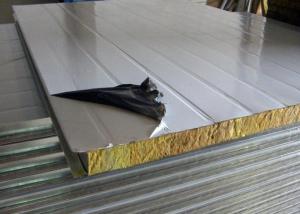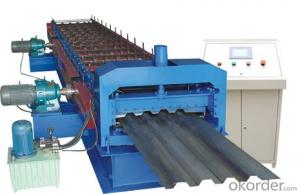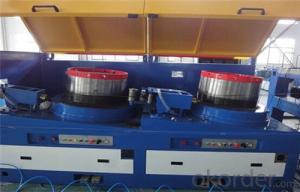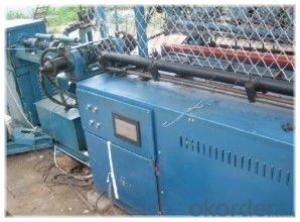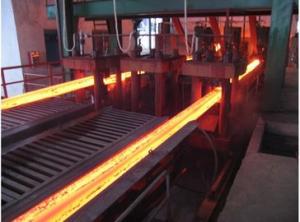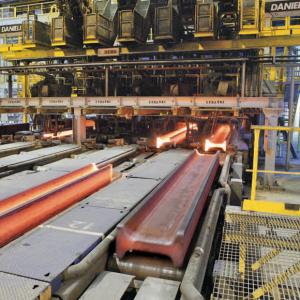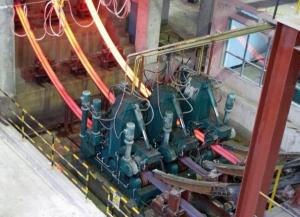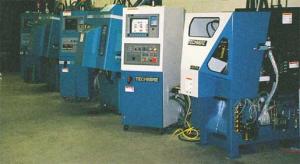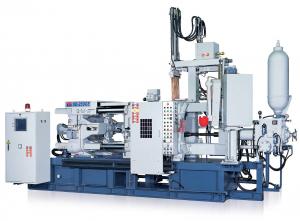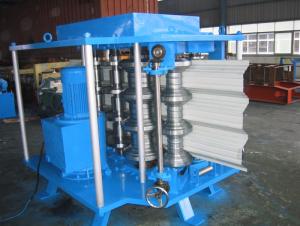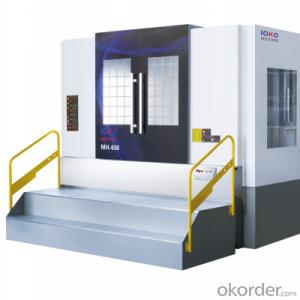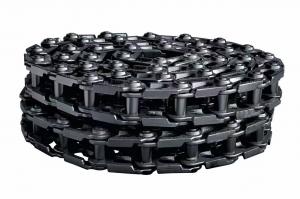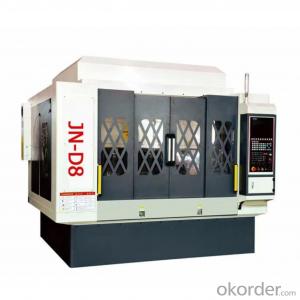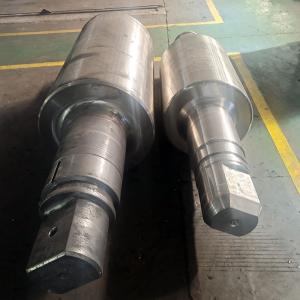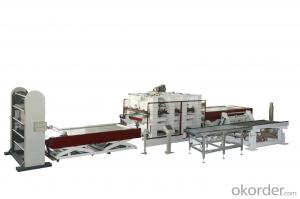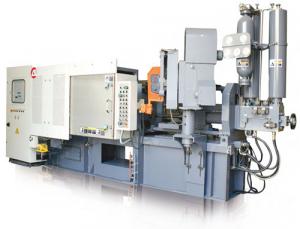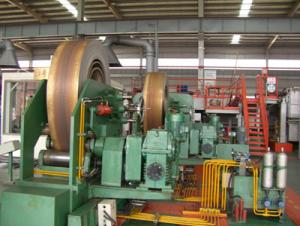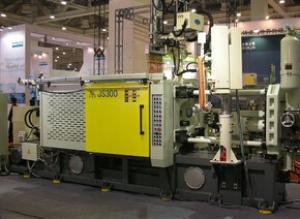Continuous Casting Machine for Steel
- Loading Port:
- China Main Port
- Payment Terms:
- TT or LC
- Min Order Qty:
- 1 Set set
- Supply Capability:
- 30 Sets Per Year set/month
OKorder Service Pledge
Quality Product, Order Online Tracking, Timely Delivery
OKorder Financial Service
Credit Rating, Credit Services, Credit Purchasing
You Might Also Like
Technology process:
1.Heat the EVA film
2.Cover the heated EVA film on the mould(can be made from wood or aluminum)
3.Spray a coating in a certain baume degree
4.Put on the empty blask
5.Sand-up the flask and vibrate to compaction
Packaging & Delivery
Packaging Details:containers
Delivery Detail:a set complete equipment needed producting three months
- Q:What is the role of inspection equipment in metal casting machinery?
- The role of inspection equipment in metal casting machinery is to ensure the quality and accuracy of the casted metal products. It is used to detect any defects, flaws, or inconsistencies in the casted parts, such as air bubbles, cracks, or dimensional variations. This equipment helps in maintaining high-quality standards, meeting specific customer requirements, and avoiding costly rework or rejection of the casted components.
- Q:How are alloys prepared and controlled for continuous casting in metal casting machinery?
- Continuous casting in metal casting machinery involves a series of meticulously planned steps to prepare and control alloys. The process follows these general steps: 1. Choosing the Alloy: The initial step is to select the suitable alloy composition for the desired end product. This decision is based on the specific mechanical, physical, and chemical properties required for the application. 2. Melting: Next, the selected alloys are melted in a furnace under controlled conditions to ensure consistency and uniformity. The temperature, atmosphere, and duration of melting are crucial factors in achieving the desired alloy properties. 3. Adding Alloying Elements: In certain cases, alloying elements are introduced during the melting process to enhance specific properties of the alloy. These elements can be added as master alloys or individual elements to attain precise control over the alloy composition. 4. Removing Impurities: To enhance the quality of the alloy, degassing and refining processes are employed. These processes eliminate impurities like oxygen, hydrogen, and non-metallic particles, which can have adverse effects on the casting quality. 5. Utilizing Continuous Casting: Once the molten alloy is ready, it is transferred to the continuous casting machine. This machine consists of a continuously cooled mold that solidifies the molten metal into a continuous strand. The casting speed and cooling rate are carefully regulated to ensure uniformity and prevent defects. 6. Controlling Temperature: Throughout the continuous casting process, the temperature of the molten alloy is closely monitored and controlled. This is essential to maintain the desired casting speed and prevent premature solidification, which can result in defects. 7. Managing Solidification: As the alloy solidifies within the continuous casting machine, various techniques are employed to control the solidification process. These techniques may include water sprays or electromagnetic devices to regulate the cooling rate, ensuring a uniform structure and minimizing defects. 8. Ensuring Quality: Various quality control measures are implemented during continuous casting to detect and eliminate defects. These measures may involve online monitoring systems, such as thermal imaging or ultrasonic testing, to identify cracks, voids, or other imperfections. In summary, the preparation and control of alloys for continuous casting in metal casting machinery require careful attention to alloy selection, melting, refining, continuous casting parameters, and quality control measures. By optimizing these steps, manufacturers can produce high-quality castings with the desired properties and specifications.
- Q:What are the considerations for mold material selection in metal casting machinery?
- When selecting a mold material for metal casting machinery, several considerations need to be taken into account. These considerations include the type of metal being cast, the complexity and intricacy of the desired shape, the expected production volume, and the cost-effectiveness of the material. Firstly, the type of metal being cast plays a crucial role in mold material selection. Different metals have varying melting points, thermal conductivity, and reactivity, which can affect the choice of mold material. For example, high-temperature alloys such as steel or iron may require a mold material that can withstand their elevated temperatures without warping or deteriorating. The complexity and intricacy of the desired shape also influence mold material selection. Some materials, such as sand or plaster, are more suitable for simple or less intricate shapes, while others like ceramic or investment casting materials can handle more complex geometries. The mold material should be able to capture and replicate the desired shape accurately, ensuring a high-quality final product. Another consideration is the expected production volume. If the production volume is high, a more durable and long-lasting mold material may be necessary to withstand the repeated use and minimize downtime. In contrast, for low-volume or prototype production, a less expensive mold material may be sufficient. Cost-effectiveness is an essential factor when selecting a mold material. The material and manufacturing costs associated with a particular mold material should be evaluated against the expected production volume and the value of the final product. While some materials may be more expensive upfront, they could offer longer lifespan or better performance, leading to cost savings in the long run. Other factors to consider include the availability of the mold material, its compatibility with the casting process, and the environmental impact associated with its production and disposal. It is also crucial to consider any specific requirements or regulations related to the industry or application in which the metal casting machinery operates. In summary, when selecting a mold material for metal casting machinery, it is essential to consider the type of metal being cast, the complexity of the desired shape, the expected production volume, cost-effectiveness, availability, compatibility, and environmental impact. Evaluating these considerations will help ensure the selection of a mold material that meets the requirements of the casting process and results in high-quality, cost-effective products.
- Q:Is there a limit to the size of castings that metal casting machinery can produce?
- Yes, there is a limit to the size of castings that metal casting machinery can produce. The size limitation is determined by various factors including the capacity and design of the casting equipment, the type of metal being used, and the capabilities of the foundry. The size of the casting machinery typically determines the maximum size of castings that can be produced. For instance, some smaller foundries may have machinery with limited capacity, which means they can only produce smaller castings. On the other hand, larger foundries with more advanced and specialized equipment may be able to produce larger, more complex castings. The type of metal being used also plays a role in size limitations. Different metals have different physical properties and behaviors during the casting process. Some metals, such as aluminum and copper alloys, have better flow characteristics and can be cast into larger sizes more easily. In contrast, other metals like steel or iron may require more sophisticated equipment to handle their higher melting temperatures and viscosity, limiting the size of the castings that can be produced. Furthermore, the capabilities and expertise of the foundry itself can impact the size of castings that can be produced. Skilled foundries with experienced technicians and engineers can often find innovative ways to overcome size limitations, utilizing advanced casting techniques and design modifications to produce larger castings. In conclusion, while metal casting machinery does have size limitations, the specific limitations will depend on the capacity and design of the equipment, the type of metal being used, and the capabilities of the foundry. However, with advancements in technology and expertise, the size limitations are continuously evolving, enabling the production of increasingly larger castings.
- Q:What are the common troubleshooting procedures for metal casting machinery?
- To identify and resolve issues with metal casting machinery, there are several troubleshooting procedures that can be followed. These procedures encompass the following: 1. Conduct a thorough visual inspection of the machinery to detect any visible signs of damage, misalignment, or wear. Look for loose or broken components, leaks, and unusual noises. 2. Ensure that the machinery is receiving the correct power supply and that the voltage and current levels fall within the recommended range. Verify the security of connections and check that the circuit breaker has not been tripped. 3. Check the lubrication levels and make sure that all moving parts are adequately lubricated. Inadequate lubrication can cause friction, which in turn leads to machinery malfunctions. 4. Regularly clean the machinery to eliminate dirt, debris, and built-up residue. Unclean equipment can cause clogs, blockages, or reduced efficiency. 5. Verify that all sensors, gauges, and control systems are calibrated correctly. Incorrect calibration can result in inaccurate readings or improper functioning of the machinery. 6. Assess the settings and operating parameters such as temperature, pressure, speed, and flow rates. Ensure that they fall within the recommended range for the specific metal casting process. 7. Inspect the cooling systems, such as water lines or cooling jackets, for any blockages or leaks. Inadequate cooling can lead to overheating, which can ultimately result in machinery failure. 8. If a specific component is suspected of causing the issue, focus troubleshooting efforts on that particular part. Inspect it for damage, misalignment, or wear, and consider replacing or repairing it if necessary. 9. Refer to the machinery's manuals and documentation to gain a comprehensive understanding of its operation, maintenance requirements, and troubleshooting guidelines. Adhere to the manufacturer's recommendations for any specific troubleshooting procedures. 10. If the issue persists or is beyond your expertise, it is advisable to contact a qualified technician or the machinery manufacturer's support team. They can offer further guidance and assistance in troubleshooting and resolving complex issues. During troubleshooting, it is crucial to observe safety precautions, including wearing appropriate personal protective equipment and disconnecting power sources before inspecting or repairing machinery.
- Q:How does metal casting machinery prevent the formation of cracks in castings?
- Metal casting machinery employs a variety of techniques and processes to hinder the occurrence of cracks in castings. A primary method involves the regulation of the cooling rate during the solidification process. By skillfully controlling this rate, the machinery ensures uniform solidification of the molten metal, thereby decreasing the likelihood of cracks caused by uneven cooling or thermal stress. Another approach employed by metal casting machinery to prevent cracks is the utilization of appropriate gating and risering systems. These systems ensure a consistent flow of molten metal into the mold, preventing the formation of voids or trapped air that may lead to cracks. Additionally, the gating and risering systems aid in controlling the solidification process, enabling a more regulated cooling rate and minimizing the chances of thermal stress-induced cracks. Furthermore, metal casting machinery incorporates the use of cores and chill plates to prevent cracks in castings. Cores are utilized to create internal cavities or intricate shapes in the casting, providing additional support and stability during solidification. Chill plates, on the other hand, rapidly cool specific areas of the mold, preventing the formation of hot spots that could give rise to cracks. Moreover, metal casting machinery may introduce various additives or alloying elements to enhance the mechanical properties of the casting and reduce the likelihood of cracks. These additives enhance the metal's resistance to thermal stress and contribute to improved overall structural integrity. In conclusion, metal casting machinery effectively prevents cracks in castings through the regulation of the cooling rate, the implementation of proper gating and risering systems, the utilization of cores and chill plates, and the incorporation of additives or alloying elements. By meticulously managing these factors, metal casting machinery ensures the production of castings with minimal defects and optimal structural integrity.
- Q:How does metal casting machinery handle the removal of dimensional inaccuracies from the castings?
- Metal casting machinery handles the removal of dimensional inaccuracies from castings through a process known as post-casting machining. This involves using various machining techniques to shape and refine the castings to meet the desired specifications and tolerances. One common method used is called milling, where a rotating cutting tool is used to remove excess material and achieve the required dimensions. Milling machines can be programmed to follow specific paths and remove material from specific areas of the casting to correct any dimensional inaccuracies. Another technique is turning, which involves rotating the casting against a stationary cutting tool. This process is often used to create cylindrical shapes and remove excess material from the outer surfaces of the casting. Grinding is another method used to remove dimensional inaccuracies. It involves using an abrasive wheel to remove material and achieve the desired surface finish. This technique is particularly useful for correcting surface imperfections and achieving precise dimensions. In addition to these techniques, metal casting machinery may also employ drilling, boring, or tapping to create holes or threads in the castings. These processes are useful for achieving accurate dimensions and ensuring proper functionality of the final product. Overall, metal casting machinery employs a combination of machining techniques to remove dimensional inaccuracies from castings. These processes are carefully controlled and monitored to ensure the final product meets the required specifications and tolerances.
- Q:What are the different types of insurance and risk management strategies for metal casting machinery?
- Metal casting machinery can be safeguarded through a variety of insurance options and risk management tactics. These approaches aim to shield both the machinery itself and the overall business, as well as its employees, from potential hazards and financial losses. Here are some commonly utilized insurance policies and risk management strategies for metal casting machinery: 1. Property insurance: This kind of insurance covers the physical assets of the business, including the metal casting machinery, and guards against risks such as fire, theft, vandalism, and natural disasters. In the event of such incidents, property insurance provides financial compensation to repair or replace the machinery. 2. Equipment breakdown insurance: Specifically designed for metal casting machinery, this insurance policy covers mechanical failures and breakdowns. It includes coverage for repair expenses, replacement parts, and even losses incurred due to business interruption caused by the breakdown. 3. Business interruption insurance: In the event of significant disruptions to metal casting operations, like fires or equipment breakdowns, business interruption insurance helps mitigate the loss of income during the downtime. It offers financial support for ongoing expenses, such as payroll and rent, and aids in the recovery of the business. 4. Liability insurance: Liability insurance protects businesses from claims or lawsuits resulting from accidents or damages caused by their metal casting machinery. It covers legal fees, settlements, and other associated costs. Liability insurance can also include product liability coverage to safeguard against injuries or damages caused by the machinery to third parties. 5. Workers' compensation insurance: This insurance is essential for protecting employees in case of work-related injuries or illnesses. It covers medical expenses, rehabilitation costs, and lost wages for injured workers. Workers' compensation insurance is mandatory in most jurisdictions and ensures proper care and financial assistance for affected employees. 6. Risk assessment and management: In addition to insurance, risk assessment and management strategies play a crucial role in minimizing potential risks. Regular inspections, maintenance, and training programs help identify and mitigate risks associated with metal casting machinery. Implementing safety protocols, providing protective equipment, and ensuring proper employee training significantly reduce the likelihood of accidents and injuries. By combining different insurance policies and risk management strategies, businesses in the metal casting industry can effectively safeguard their machinery, employees, and overall operations from potential risks and losses. It is important to consult with insurance professionals and risk management experts to customize the insurance coverage and strategies according to the specific needs of the business.
- Q:What are the different types of chemical composition inspection methods used in metal casting machinery?
- To ensure the quality and integrity of castings in metal casting machinery, various chemical composition inspection methods are utilized. These methods play a crucial role in evaluating the suitability of the metal for its intended application. 1. Spectroscopic Analysis: Spectrometers are employed in this method to analyze the elemental composition of the metal. It accurately determines the percentage of different elements present in the alloy, including major and trace elements. Spectroscopic analysis yields rapid and reliable results, making it a widely utilized technique in metal casting machinery. 2. X-Ray Fluorescence (XRF): XRF is a non-destructive technique used to determine the chemical composition of metallic samples. It involves using X-ray beams to excite the atoms in the metal, leading to the emission of characteristic fluorescent X-rays. By measuring the energy and intensity of these emitted X-rays, the composition of the metal can be ascertained. 3. Optical Emission Spectroscopy (OES): OES relies on the emission of light from excited atoms to analyze the elemental composition of metals. This technique involves vaporizing a small portion of the metal sample using a high-frequency spark or arc. The emitted light is then analyzed to determine the concentration of different elements in the sample. 4. Inductively Coupled Plasma (ICP): ICP employs a plasma source to ionize the atoms in the metal sample and analyze their elemental composition. The sample is introduced into a high-temperature plasma, and the resulting ions are measured using a mass spectrometer. ICP exhibits high sensitivity and can detect trace elements present in the metal. 5. Wet Chemical Analysis: This method entails dissolving the metal sample in a chemical solution, followed by a series of chemical reactions to determine the concentration of different elements. Wet chemical analysis is a time-consuming process typically employed when other methods are unavailable or when a high level of accuracy is required. These diverse chemical composition inspection methods provide valuable insights into the composition of the metal used in casting machinery. By ensuring the appropriate chemical composition, manufacturers can produce high-quality castings that meet the necessary specifications and performance standards.
- Q:What are the different types of ladles used in metal casting machinery?
- There are several different types of ladles used in metal casting machinery, each designed for specific purposes and requirements. 1. Hand ladles: These ladles are manually operated and are commonly used for small-scale casting operations. They are typically made of heat-resistant materials like steel or iron, and their capacity can range from a few ounces to several pounds. 2. Crane ladles: As the name suggests, these ladles are designed to be lifted and transported by overhead cranes. They are often used in larger foundries or industrial settings where heavy loads of molten metal need to be moved efficiently and safely. Crane ladles can have capacities ranging from a few hundred pounds to several tons. 3. Teapot ladles: Teapot ladles are smaller ladles with a long, curved spout resembling a teapot. They are specifically designed for pouring molten metal into small or intricate molds, where precision and control are crucial. The spout allows for accurate pouring and reduces the chances of splashing or spillage. 4. Bottom-pour ladles: These ladles have a bottom discharge mechanism that allows for controlled pouring of molten metal. They are commonly used in continuous casting processes where a steady flow of metal is required. The bottom discharge ensures a consistent flow rate and minimizes turbulence, resulting in higher-quality castings. 5. Lip-pour ladles: Lip-pour ladles feature a spout or lip on the side of the ladle for pouring molten metal. They are commonly used in gravity casting processes, where the ladle is tilted to pour the metal into the mold. Lip-pour ladles are versatile and can be used for both small and large-scale casting operations. 6. Ladle preheaters: These are not ladles themselves but rather a type of equipment used to preheat ladles before they are filled with molten metal. Preheating the ladles helps to maintain the temperature of the metal and prevent premature solidification, ensuring optimal casting conditions. These are just a few examples of the different types of ladles used in metal casting machinery. The choice of ladle depends on factors such as the scale of the casting operation, type of metal being poured, and specific requirements for pouring accuracy and control.
Our professions include metallurgical technology, equipment and automation. We can provide the best solutions to the production process, design & manufacture of equipment and electrical automation regarding various industries in domestic and foreign districts with exquisite technology and fine quality service. We can provide all-around services to customers from development & design to the provision, installation and running of products.Strong technical strength, advanced equipment manufacturing technology, fine quality professional talents, and perfect service systems all bring about reliability, relaxation, convenience and delight to the cooperation with customers from beginning to end.
1. Manufacturer Overview |
|
|---|---|
| Location | Jiangsu,China (Mainland) |
| Year Established | 2000 |
| Annual Output Value | |
| Main Markets | South America Eastern Europe Southeast Asia Africa Mid East South Asia Domestic Market |
| Company Certifications | |
2. Manufacturer Certificates |
|
|---|---|
| a) Certification Name | |
| Range | |
| Reference | |
| Validity Period | |
3. Manufacturer Capability |
|
|---|---|
| a)Trade Capacity | |
| Nearest Port | SHANGHAI |
| Export Percentage | 21% - 30% |
| No.of Employees in Trade Department | 3-5 People |
| Language Spoken: | English, Chinese |
| b)Factory Information | |
| Factory Size: | |
| No. of Production Lines | |
| Contract Manufacturing | |
| Product Price Range | |
Send your message to us
Continuous Casting Machine for Steel
- Loading Port:
- China Main Port
- Payment Terms:
- TT or LC
- Min Order Qty:
- 1 Set set
- Supply Capability:
- 30 Sets Per Year set/month
OKorder Service Pledge
Quality Product, Order Online Tracking, Timely Delivery
OKorder Financial Service
Credit Rating, Credit Services, Credit Purchasing
Similar products
New products
Hot products
Hot Searches
Related keywords


